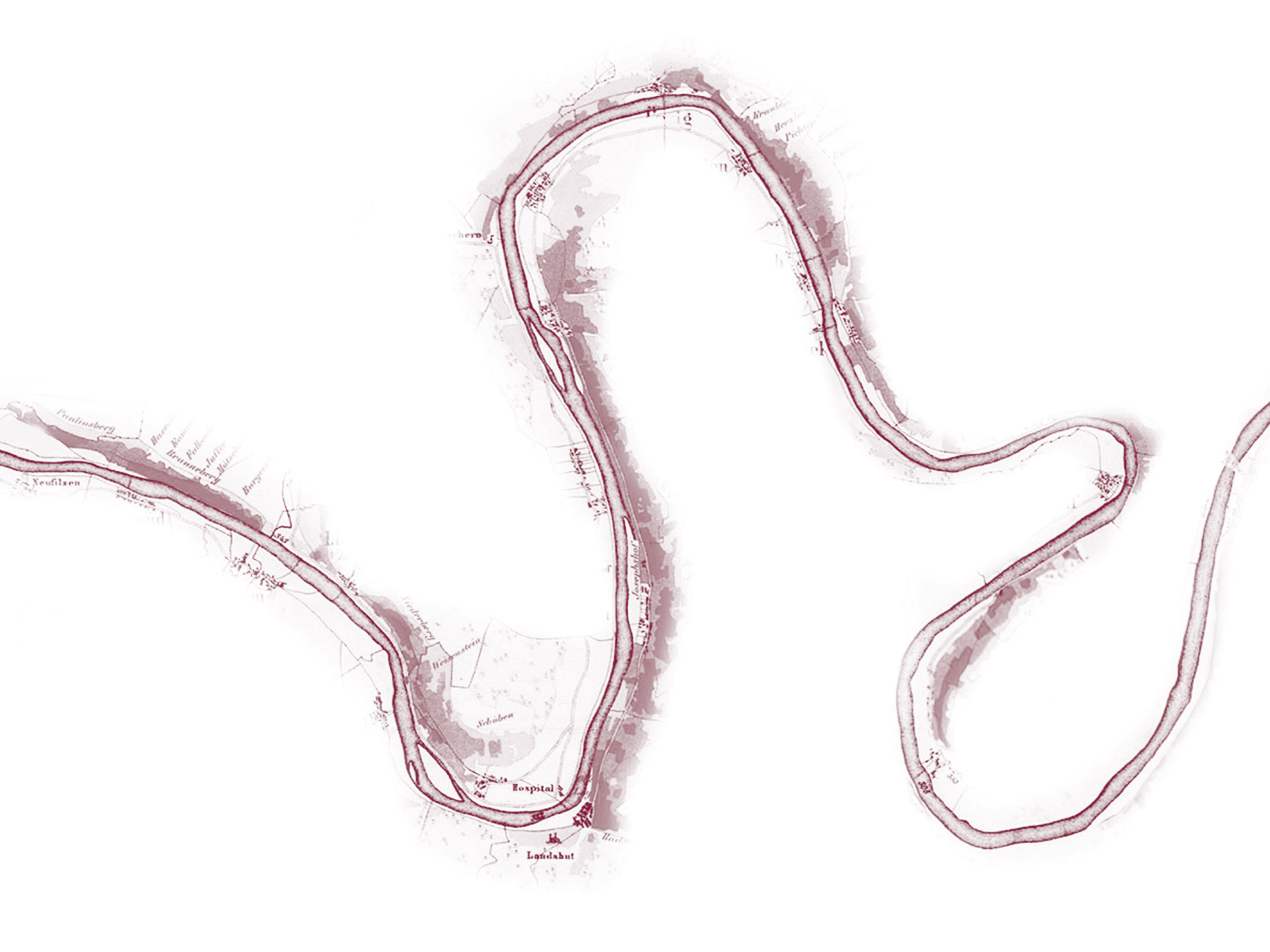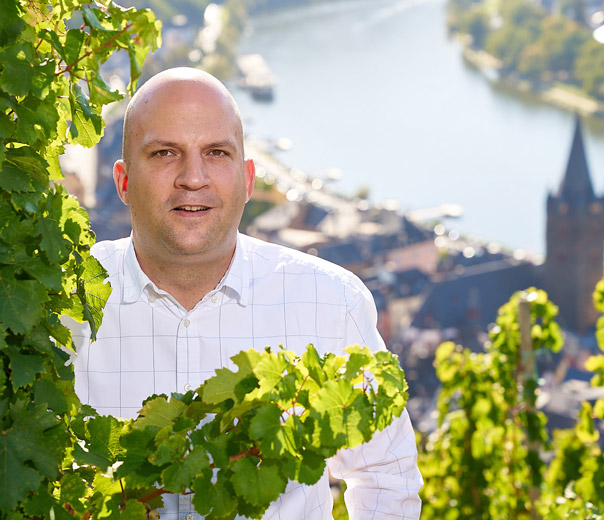
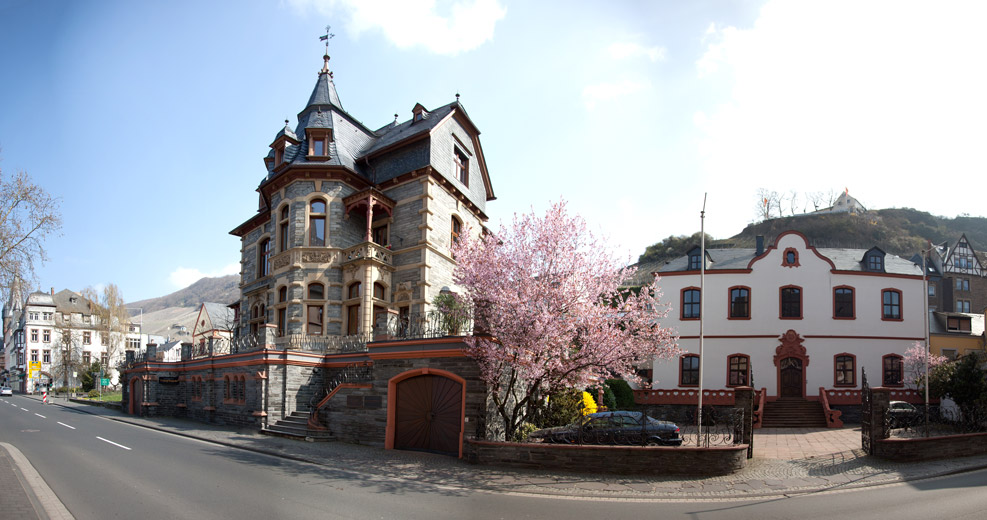
Extensive care of these vineyards, combined with intentionally low yields and selective handpicking, serve as guarantors for our extraordinary wines and their individual and unique character. Thereby the most important asset of the Dr. Pauly-Bergweiler Wine Estate consists of its vineyards.
Our quality orientation is continued in our work in the wine cellar. The Riesling grapes are processed in modern facilities just outside of Bernkastel. Our work flow is focused on gentle treatment of the grapes and the young wines. The wines are made carefully in order to insure that the typical tastes and aromas of a given vineyard are maintained.
We use small stainless steel tanks where the grapes of each different vineyard are fermented separately. We have 15 different vineyard sides between the villages of Brauneberg and Erden on a stretch of 20 km (12,5miles), and every single vineyard has its own character. The fermentation is temperature-controlled and kept very slow and at low temperatures to retain the diversity of aromas and the vitality of the wines.
Our collection of Riesling wines is very diverse. In most vintage years we have all the varieties found on a good wine menu, ranging from a juicy, hearty table wine to fine quality wine and further to a creamy, sweet dry berry selection.
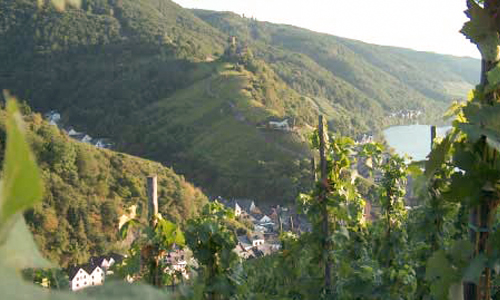
The Bernkasteler Schlossberg is located directly under the Burg Landshut, an ancient castle that gave the vineyard its name.
The southwest-facing slopes have elevations of up to 300 meters above sea level and are mainly formed by a strongly skelletized slate residual soil having a small portion of topsoil. This more rugged soil type brings lower yields and more concentrated minerality.
The castle was first mentioned in Bernkastel in the 7th century as „Primumcastellum“. In the year 1280 the castle came into the ownership of the Archbishops of Trier and was used as their summer residence.
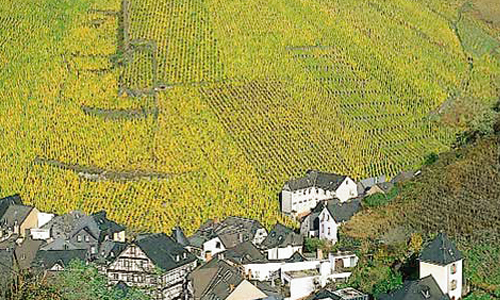
The alte Badstube am Doctorberg is the best vineyard of the wine estate It is only 1.8 ha in size and it is held to 100% in the hands of the Pauly-Family. As the name indicates, this vineyard is a neighbor to the famous „Bernkasteler Doctor“ and the winegrowing conditions are quite similar.
The stony blue-grey clay slate is a residual soil having a very good heat-storing potential, which makes it possible to produce quality grapes for high-end wines. The high proportion of blue slate gives the wine a high content of minerals and finesse. Because of the age of the vines (in part more than 70 years old) the yield in this vineyard is very low – only 55 to 65 hl/ha.
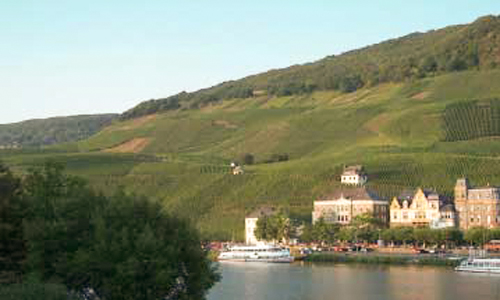
Our largest vineyard is the Bernkasteler Badstube, where we have almost 6 ha of the total area of 68 ha, which begins at the northwest end of Bernkastel.
The main soil type in the Bernkasteler Badstube is a medium-deep clay-slated residual soil having varying parts of loam and stone mineral content. In some areas one encounters pure slate having a high mineral content. The old vines, grown by Moselle post-type training, produce every kind of high quality wine ranging from the elegant Kabinett to the full-bodied and noble Auslese (berry selection).
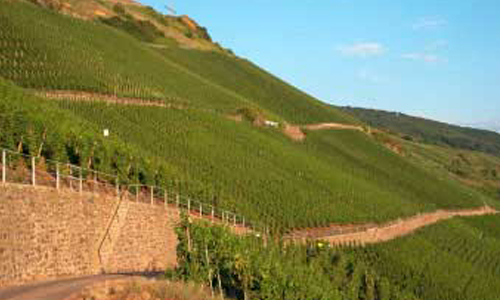
The 0.5 hectares that we hold in the lower levels of this steeply sloped location face southwest and provide excellent growing conditions for Spätburgunder (Pinot Noir), a grape variety planted in Graacher Domprobst in 1986 after land consolidation, making it one of the oldest Spätburgunder vineyards in the area.
The soil is deep to medium-deep, and the weathered stony slate soil has clay content in the upper layer. A clay terrace underneath the 15-foot thick slate topsoil is conducive to a good channeling of water to the vineyard.
The name „Domprobst“ is directly connected to the Cathedral Provost (Domprobst) of Trier, who, prior to the secularization which started via Napoleon at the beginning of the 19th century, got one-third of the 10% share that was levied as a wine tax in Graach.
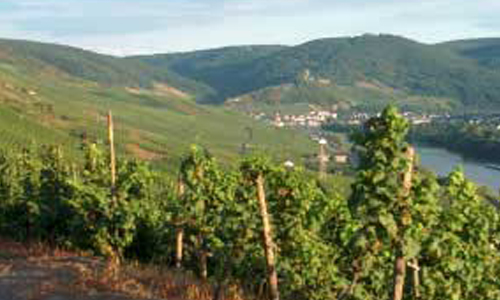
„Graacher Himmelreich“ is the largest single vineyard in the town of Graach, the direct neighbor to Bernkastel-Kues. The Estate holds many small parcels in Graacher Himmelreich, totalling 1.2 hectares.
The terroir of the „Himmelreich“ in Graach consists mainly of weathered medium-depth slate soil, combined with a low content of clay. The vineyard is located 110 to 260 meters above sea level and the slopes are steep throughout. The wines from this vineyard are full-bodied and juicy, and in some years also robust and noble.
The appellation „Himmelreich“ is applied to this elevated vineyard location because it means „heavenly domain“. Some sources even say that the vineyard is named after the local cemetery where the vineyard’s domain begins.

„Wehlener Sonnenuhr“ (Sundial of Wehlen) is a vineyard located in the heart of the Middle Moselle wine region, directly opposite the well-known wine village of Wehlen. The small south-southwest-facing terraces reach up to 250 meters above sea level.
Bluish-grey, primarily stony slate from the Devonian Period forms an especially good reservoir for heat, storing the heat during the day and releasing it to the vines during cool nights. Deposits of loess and quartzite bring additional mineral components to the wine. The increased work demanded by cultivating the steepest area right around the sundial is rewarded each year by outstanding Riesling wines, largely produced from older self-rooted grapevines.
The sundial in the vineyards at the Wehlener Sonnenuhr location was erected in the 19th century by Jodocus Prüm, one of the ancestors of the Dr. Pauly-Bergweiler Estate. The Riesling wines from this vineyard have a fruity elegance combined with a lively character, and there is no doubt that these wines are among the best-known and most noble white wines in the world.
Quotation from Dr. Dr. Karl Christoffel, a deceased member of the family (freely translated from german):
As the sundial on the wall,
Brightens up the blue slate ways
Praise the heavenly fire above,
Blessing grapevines with its rays.

The 12 hectare vineyard of Wehlener Klosterberg is located in a small tributary valley on the left side of the Moselle River.
The southeast-facing vineyard reaches from 210 to 240 meters above sea level. The roots of the vines grow into medium-deep clay slate soil having a high stone content. The Riesling wines from this vineyard are comparable with the filigree elegance of wines from the Saar Valley.
The name of this vineyard can presumably be traced back to a convent which originally existed on the present-day location of the Machern convent, „Kloster Machern“.
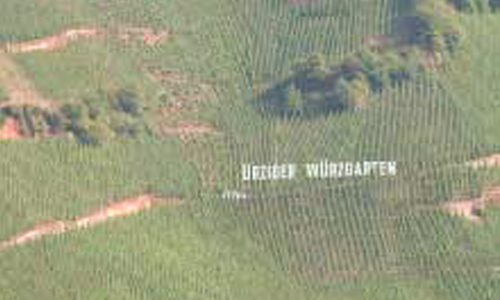
Ürziger Würzgarten is one of the most impressive vineyards in the Middle Moselle region and is one of two vineyard sites in Ürzig. One hectare is owned by the former Peter Nicolay Estate, at that time located in Ürzig, and representing the largest vineyard in that estate.
The red-colored slopes are planted with vines up to an elevation of 320 meters above sea level. The vineyard faces south-southeast and the terroir shows strong influence from the volcanic „Eifel“, which makes it unique in the Moselle region.
The soil is a mixture of red slate and sandstone which provides a reservoir for heat storage and also produces diversified mineral content.
Grapes grown here from self-rooted Riesling vines annually produce great wines with exotically spicy aromas that find no equal anywhere for their kind.
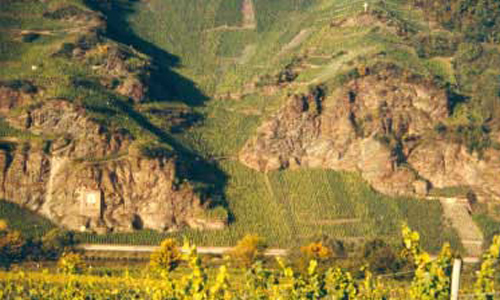
The Ürziger Goldwingert vineyard is less than 0.3 hectares (0.74 acres) in size and is therefore one of the smallest vineyards in Germany.
The vineyard starts at an elevation of 110 meters, nearly the same level as the Moselle River, and reaches up only 40 meters from bottom to top. Ürziger Goldwingert is bordered on three sides by high stone cliffs and faces south. Together with the surface of the Moselle River, this location creates a nearly Mediterranean microclimate.
The self-rooted Riesling vines grow on deep grey-red slate soil with a high stone content. The red color comes from oxidized red iron compounds in the soil which give this slate its German appellation „Rotliegendes“ (red slate soil). Wines grown in the Ürziger Goldwingert have outstanding elegance combined with classy fruitiness and lively harmony.
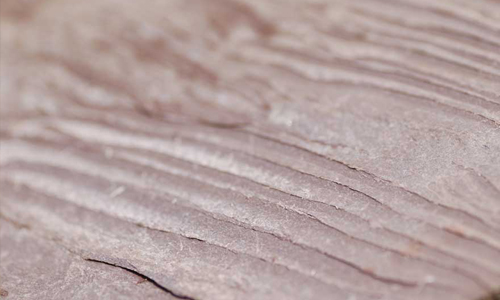
The vineyard Erdener Prälat is also part of the property of the former Peter Nicolay Estate in Ürzig. It is located right next to Ürziger Goldwingert, but differs as a vineyard because of the structure of its soil.
The shallow to medium-deep weathered slate soil of this stony vineyard produces noble Riesling wines possessed of a fine fruitiness and having few equals. These wines justify the much greater amount of work required to cultivate the vines in this vineyard.

Erdener Treppchen is the largest of the three vineyards of the small wine village of Erden. Erdener Treppchen – just as its companion Erdener Prälat – grows across the Moselle River on the opposite side from the village of Erden. The third vineyard is Erdener Busslay, which is located on same side of the river as the village.
Erdener Treppchen faces south and the many cliffs surrounding the vineyard create a very special microclimate. The soil is medium-deep to deep and consists mainly of stony, weathered slate. The Riesling wines from this vineyard are fine, noble and classy with good fruitiness and elegance.
The name Treppchen is a diminutive form of Treppe, meaning „stairs“, but in the regional dialect and applied to this vineyard it means „terraces“.
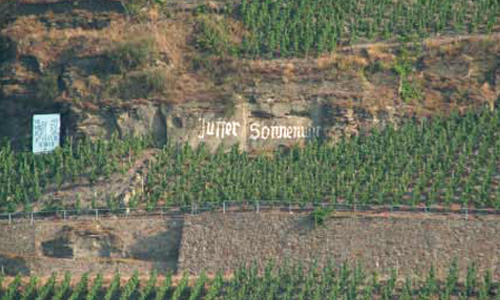
The best location on the famous Brauneberger Juffer vineyard is Brauneberger Juffer-Sonnenuhr. The Estate has parcels in one of the steepest parts of the vineyard, which is thus predestined for the production of extra-premium quality wines.
„Brauneberg“ means „brown hill“, which is accounted for by the shallow and stony brownish-colored soil of this vineyard. The clay slate soil has a high mineral content and permits the production of elegant, classy wines with great breadth and fine fruitiness.
The term Juffer is local jargon for ”unmarried daughter“ and appeared for the first time in the year 1790, when the three unmarried daughters of the chamberlain of the electoral palatinate made wine at this location and thus made Brauneberger Juffer-Sonnenuhr famous because of them.
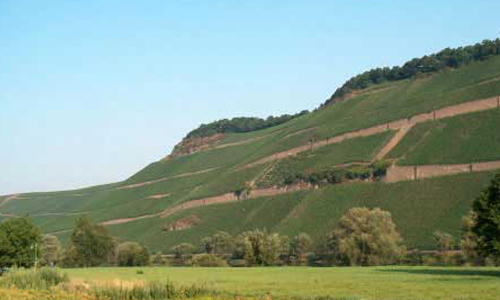
Brauneberger Juffer is a well-known vineyard location on a steep slope which stretches parallel to the Moselle River from Kesten to the confluence of the River Lieser. On the Moselle River, it is located across the river from the town of Brauneberg.
The soil is medium-deep to shallow and has a very low content of fine earth. The weathered and stony clay slate soil gives the wine a strong mineral taste. Brauneberger Juffer wine is marked by robust and classy Rieslings having a lot of fruitiness.
Already in ancient days, the Romans were aware of this optimal location and used it for wine-growing. The old Roman wine press house at the foot of the vineyard is evidence for Roman wine production.

We are pleased to welcome you in „Dr. Paulys Probier- und Studierkeller“ (our tasting room). Grab the opportunity and taste our Riesling and our Pinot Noir collection. Where? In the chapel, in our vaulted 18th century cellar as well as in the chimneycellar or the „baroque saloon“.
Opening Hours from 7. May till 1. November 2022
(2. November 2022 till Eastern 2023 by appointment only:
Monday, Tuesday and Wednesday by appointment
Thursday and Friday from 14:00 till 18:00 Uhr
Saturday from 14:00 till 18:00 Uhr; we are offering a general, commented wine tasting at 16:00 p.m. (by appointment).
Sunday by appointment.
We are happy to help you plan your wine tasting; for prices or desired dates, please contact our office (Tel. +49 6531 3002, info@pauly-bergweiler.com or by post at Gestade 15 in 54470 Bernkastel-Kues); Office hours: Monday to Friday from 8:00 a.m. to 12:00 p.m.

You can find a selection of our wines @ Total Wine & More Stores throughout the USA
http://www.totalwine.com

Auszeichnungen
US Press Ratings
WineEnthusiast Vintage 2018 | Vintage 2017 | Vintage 2016 | Top 100 2012
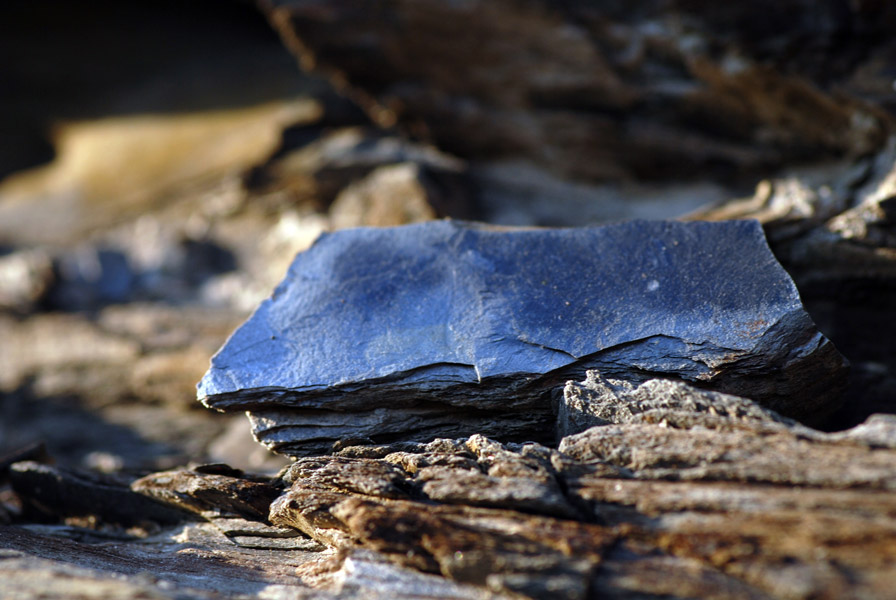
Factsheets
More details? Here you are. Just click on the site and quality level.
Dry Riesling
Riesling
Blitz Riesling
Bernkasteler alte Badstube am Doctorberg
Bernkasteler alte Badstube am Doctorberg
Riesling Kabinett
Bernkasteler alte Badstube am Doctorberg
Riesling Spätlese
Bernkasteler alte Badstube am Doctorberg
Riesling Auslese
Bernkasteler alte Badstube am Doctorberg
Riesling Trockenbeerenauslese
Bernkasteler alte Badstube am Doctorberg
Riesling Großes Gewächs
